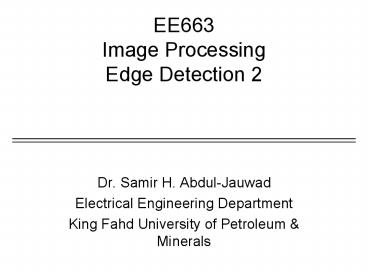EE663 Image Processing Edge Detection 2 - PowerPoint PPT Presentation
Title:
EE663 Image Processing Edge Detection 2
Description:
Edge Detection 2 Dr. Samir H. Abdul-Jauwad Electrical Engineering Department ... (discontinuity in surface orientation and/or surface color and texture) ... – PowerPoint PPT presentation
Number of Views:203
Avg rating:3.0/5.0
Title: EE663 Image Processing Edge Detection 2
1
EE663Image ProcessingEdge Detection 2
- Dr. Samir H. Abdul-Jauwad
- Electrical Engineering Department
- King Fahd University of Petroleum Minerals
2
Image Features
- Image features may appear in two contexts
- Global properties of the image (average gray
level, etc) global features - Parts of the image with special properties (line,
circle, textured region) local features
- Here, assume second context for image features
- Local, meaningful, detectable parts of the image
- Detection of image features
- Detection algorithms produce feature
descriptors - Example line segment descriptor coordinates of
mid-point, length, orientation
3
Edge Detection
- Definition of edges
- Edges are significant local changes of intensity
in an image. - Edges typically occur on the boundary between two
different regions in an image.
4
Edge Detection
- Examples
5
Edge Detection
- Goal of edge detection
- Produce a line drawing of a scene from an image
of that scene. - Important features can be extracted from the
edges of an image (e.g., corners, lines, curves). - These features are used by higher-level computer
vision algorithms (e.g., segmentation,
recognition).
6
Edge Detection
- Not that easy
7
Edge Detection
- What causes intensity changes?
- Geometric events
- object boundary (discontinuity in depth and/or
surface color and texture) - surface boundary (discontinuity in surface
orientation and/or surface color and texture) - Non-geometric events
- specularity
- shadows (from other objects or from the same
object) - inter-reflections
8
Edge Detection
- Edge descriptors
- Edge normal unit vector in the direction of
maximum intensity change. - Edge direction unit vector to perpendicular to
the edge normal. - Edge position or center the image position at
which the edge is located. - Edge strength related to the local image
contrast along the normal.
9
Modeling Intensity Changes
- Edges can be modeled according to their intensity
profiles
- Step edge
- the image intensity abruptly changes from one
value to one side of the discontinuity to a
different value on the opposite side.
- Ramp edge
- a step edge where the intensity change is not
instantaneous but occurs over a finite distance.
10
Modeling Intensity Changes
- Ridge edge
- the image intensity abruptly changes value but
then returns to the starting value within some
short distance - generated usually by lines
11
Modeling Intensity Changes
- Roof edge
- a ridge edge where the intensity change is not
instantaneous but occurs over a finite distance - generated usually by the intersection of surfaces
12
Edge Detection
- The four steps of edge detection
- Smoothing suppress as much noise as possible,
without destroying the true edges. - Enhancement apply a filter that responds to
edges in the image - Detection determine which edge pixels should be
discarded as noise and which should be retained
(usually, thresholding provides the criterion
used for detection). - Localization determine the exact location of an
edge (sub-pixel resolution might be required for
some applications, that is, estimate the location
of an edge to better than the spacing between
pixels). Edge thinning and linking are usually
required in this step.
13
Edge Detection
- Edge detection using derivatives
- Calculus describes changes of continuous
functions using derivatives. - An image is a 2D function, so operators
describing edges are expressed using partial
derivatives. - Points which lie on an edge can be detected by
either
- detecting local maxima or minima of the first
derivative - detecting the zero-crossing of the second
derivative
14
Edge Detection
- Edge detection using derivatives cont.
15
Edge Detection
- Differencing 1D signals
- To compute the derivative of a signal, we
approximate the derivative by finite differences - Computing the 1st derivative
16
Edge Detection
- Computing the 1st derivative cont.
Backward difference
Forward difference
Central difference
17
Edge Detection
- Computing the 1st derivative cont.
- Examples using the edge models and the mask -1
0 1 (centered about x)
18
Edge Detection
- Computing the 2nd derivative
- This approximation is centered about x 1
- By replacing x 1 by x we obtain
19
Edge Detection
- Computing the 2nd derivative cont.
20
Edge Detection
- Computing the 2nd derivative cont.
- Examples using the edge models
21
Edge Detection
- Image derivatives
Image I
22
Edge Detection
- Image derivatives
Image I
23
Derivatives and Noise
- Derivatives are strongly affected by noise
- obvious reason image noise results in pixels
that look very different from their neighbors - The larger the noise - the stronger the response
- What is to be done?
- Neighboring pixels look alike
- Pixel along an edge look alike
- Image smoothing should help
- Force pixels different to their neighbors
(possibly noise) to look like neighbors
24
Derivatives and Noise
Increasing noise
- Need to perform image smoothing as a preliminary
step - Generally use Gaussian smoothing
25
Edge Detection
- Possible detectors
- Gradient operators
- Roberts
- Prewitt
- Sobel
- Gradient of Gaussian (Canny)
- Laplacian of Gaussian (Marr-Hildreth)
- Facet Model Based Edge Detector (Haralick)
26
Edge Detection Using the Gradient
- Definition of the gradient
- To save computations, the magnitude of gradient
is usually approximated by
27
Edge Detection Using the Gradient
- Properties of the gradient
- The magnitude of gradient provides information
about the strength of the edge - The direction of gradient is always perpendicular
to the direction of the edge
- Main idea
- Compute derivatives in x and y directions
- Find gradient magnitude
- Threshold gradient magnitude































